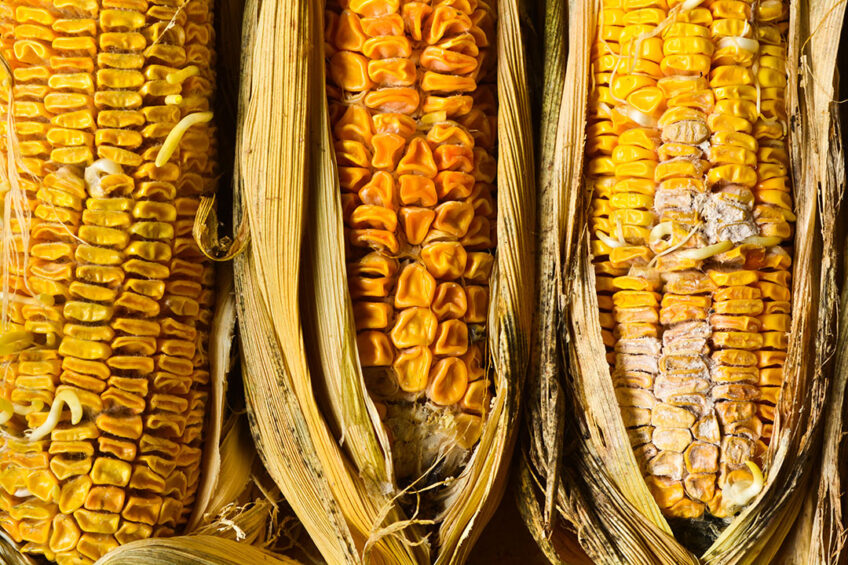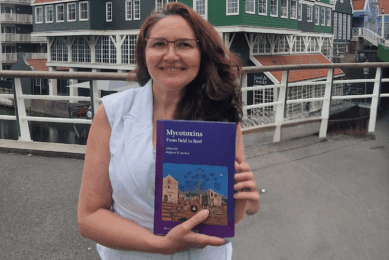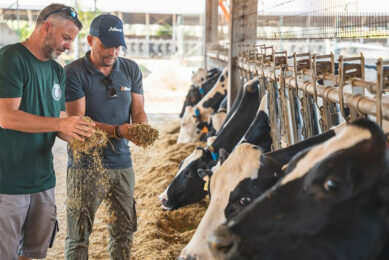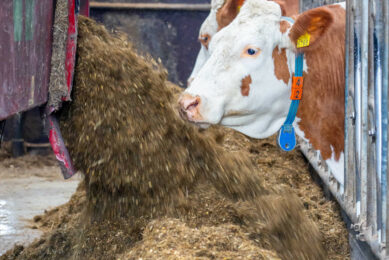Mycotoxin Analysis: 90% of samples show presence of DON

Trouw Nutrition, a Nutreco company, recently released findings from the 2019 Global Mycotoxin Risk Analysis in a live webinar. The analysis includes more than 21,000 ingredient and finished feed samples collected from 38 countries across Europe, North America, South/Central America, Middle East/Africa and Asia.
90% of samples showed presence of DON
The analysis shows that of the global crop samples collected in 2019, more than 90% had a quantifiable presence (>100 ppb) of DON, with between 80 and 90% of samples showing FUMO, AFLA, OTA and ZEA T-2 levels were lowest, at about 70%. (Figure 1). The 2019 mycotoxin risk analysis includes analysis for individual ingredients, complete feeds and silages including small grains (wheat and barley) which tested at as high as 88% for DON, to 59% for AFLA. Among byproducts, concentrations in DDGS were significantly higher than in maize, with levels approaching 5,000 ppb. Looking at protein meals, concentrations of mycotoxins were relatively low compared to cereal grains. However, soybean meal is used at about 25-30% of monogastric diets, and hence can contribute significantly to concentration of toxins in final feed. Sunflower meal showed the greatest concentration of FUMO while levels of DON, AFLA and ZEA were lower. Among silages, 100% of maize and grass silage samples showed mycotoxin contamination with concentrations that can cause toxicity in ruminant animals.

Figure 1: Samples showing % contamination with various mycotoxins.

84% of complete feeds contaminated
Looking at complete feeds including pig, poultry, ruminant and aquaculture, around 84% of samples showed contamination (Figure 2). Evaluating pig feed, samples were found to contain DON at 623 ppb, FUMO at 1662 ppb and ZEA at 52 ppb – a level that may present a synergistic toxicity threat to pigs.
In poultry feed, DON and FUMO present the greatest risk at 985 ppb and 2,110 ppb respectively. Taken together, these levels can impose a challenge on the bird’s immune system and may also exert a negative effect on the feed conversion ratio.
Figure 2: Ruminant feeds showed highest contamination % followed by poultry, swine and aquaculture.

Global ruminant samples find DON with an average concentration of 1,100 ppb and ZEA with 53 ppb, which can compromise health and performance of dairy cows. On the other hand, AFLA at 5.6 ppb can make it challenging to keep the aflatoxin M1 level in milk below the EU’s regulation of 0.05ppb.
As farmers around the globe strive to feed 7.9 billion people in a healthy, safe and sustainable way, mitigating mycotoxin risk supports feed to food safety across the supply chain.” – Dr Swamy Haladi, Trouw Nutrition’s Global Programme Manager for Mycotoxin Risk Management.
Evaluating risk around the globe
Crop growing conditions, species of animals raised, and the raw materials used in feeds vary around the globe. Trouw Nutrition analysed common mycotoxins across the regions of South/Central America, Europe, Asia, Middle East/Africa, and North America. DON, FUMO, ZEA, and AFLA contamination was quite similar across the regions except for NA where AFLA had low risk (Figure 3). T-2 toxin and OTA contamination levels were quite different across regions. In South and Central America, high levels of DON, FUMO and ZEA pose a synergistic threat (Table 1). Asia’s primary mycotoxin threat is FUMO and AFLA; but while Asia’s DON levels pose a challenge for swine, they do not present a risk for poultry. In North America (Canada), DON and ZEA are key toxins. In the Middle East/Africa region, DON, AFLA and ZEA are primary mycotoxins and DON and ZEA are the most prevalent mycotoxins in Europe.
Figure 3: As per 2019 analysis, samples from SCA were the most contaminated followed by Europe, MEA, Asia and North America.

Weather conditions’ impact on mycotoxin risk
Regional weather conditions contributed to varying mycotoxin risks across geographies in 2019. In the US, spring floods in the northern plains and Midwest delayed planting and harvesting of maize, allowing crops to stay in the fields longer and experience more mycotoxin exposure. High temperatures from Texas to the Carolinas supported the increased synthesis of AFLA and FUMO in US maize crops. In Europe, a heat wave led to poor soil moisture, compromising crop quality while maize conditions in China were generally favourable. Turning to wheat, conditions in the Ukraine resulted in a mostly favourable crop, while excess moisture in Canada’s Eastern provinces delayed planting.
A look at preliminary 2020 Q1 Data
An analysis of samples collected and analysed by the Mycomaster between January and March 2020, suggests mycotoxin contamination levels are slightly lower than in 2019, but it is too early to get a full picture (Table 2). Average concentration levels of DON were 557 ppb; clearly toxic to pigs. AFLA concentrations were 7.8 ppb, above the EU threshold of 5 ppb. The preliminary data suggests high toxicity to pigs, moderate toxicity to ruminants and low toxicity to poultry.
Remarking on the continually shifting mycotoxin landscape, Dr Swamy Haladi, Trouw Nutrition’s Global Programme Manager for Mycotoxin Risk Management, states, “While the biological susceptibility of crops and environmental conditions cannot be controlled, understanding the presence, concentrations and physiological risks various mycotoxins present to each species through our extensive global database can help farmers manage mycotoxin risk effectively.” Helping farmers manage this risk and produce safe food in a sustainable manner, Trouw Nutrition conducts more than 400 mycotoxin analyses each week evaluating feed ingredients sourced from leading exporters including Argentina, Brazil, Ukraine and US Data allows stakeholders to understand the mycotoxin profile of raw materials and make an informed decision on the level of inclusion of such raw materials in various animal feeds. Dr Haladi notes, “As farmers around the globe strive to feed 7.9 billion people in a healthy, safe and sustainable way, mitigating mycotoxin risk supports feed to food safety across the supply chain.”
Mycotoxin Knowledge Centre:
This interactive tool provides information on the impact on livestock health, an A-Z, plus regulations.
Join 13,000+ subscribers
Subscribe to our newsletter to stay updated about all the need-to-know content in the dairy sector, two times a week.










